No doubt, Salt Lake City is in the midst of a golden age flourishing in an astounding network of murals. Street art and public art traditions have found their way into exhibitions at two of the city’s foremost museums, including the newest show at the Utah Museum of Fine Arts. Murals with Utah community themes also have been commissioned for buildings covering three major downtown projects that recently have opened their doors. And, celebrating its newest brand image campaign celebrating the city’s surprising, unconventional (or, precisely, West of Conventional) features, Visit Salt Lake has collaborated with the Utah Arts Alliance and the county mayor’s office to present a mural tour pass highlighting large-scale works created by ten Utah artists.
UTAH MUSEUM OF FINE ARTS: 2020: FROM HERE ON OUT
The recent transformation in the Utah Museum of Fine Arts’ (UMFA) G. W. Anderson Family Great Hall is stunning. For approximately four years, Great Salt Lake and Vicinity, an installation artwork by Spencer Finch, featuring more than 1,100 Pantone color swatches, had encircled the hall’s perimeter in a thin strip. But, now four exceptional murals by local artists make the space resonate in an unforgettable way, especially for many museum visitors who have returned to the UMFA for the first time since before the pandemic shutdown.
It is the latest example of public art’s ascending star in Salt Lake City’s visual arts scene, particularly with how artists from the street truly have leveled the playing field when it comes to merit, reputation, aesthetic impact and cultural value in museum and gallery spaces as well as the community.
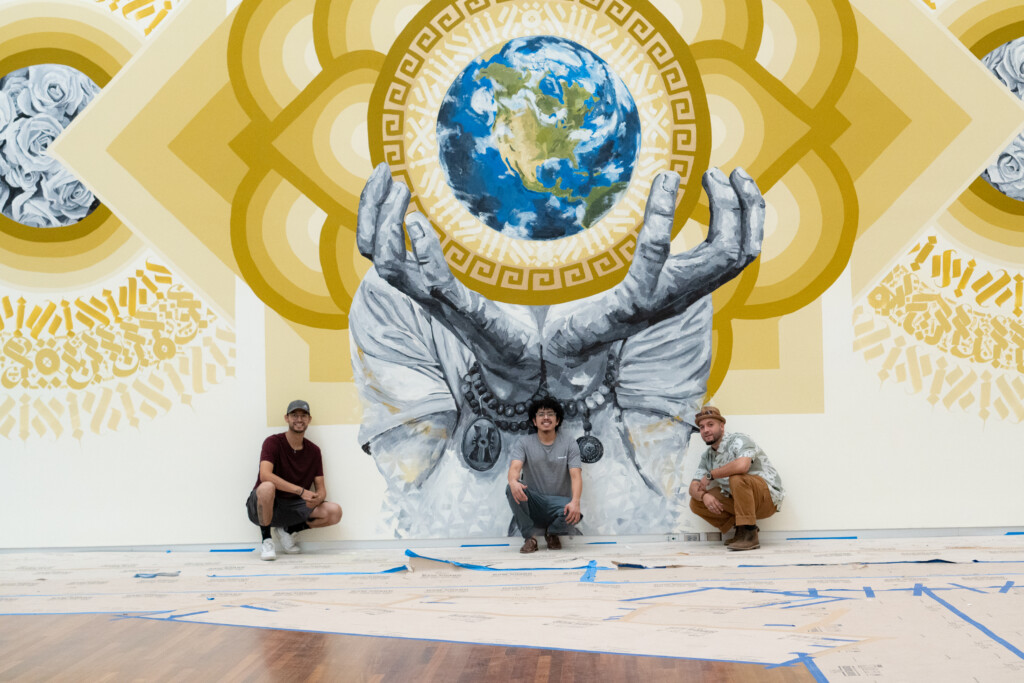
At the heart of the partnership is the locally based trio known as the Roots Art Kollective, which helped organize the project resulting in murals that reflect a multidimensional gathering of emotions, memories, experiences, lessons and epiphanies arising from the pandemic. The cumulative visual impact is an explosion of vibrance, celebration, remembrance, dignity, spirituality and poignancy.
Participating artists for the mural project 2020: From Here on Out were selected by a committee of community partners including Artes de México en Utah,The University of Utah’s Department of Art and Art History, University Neighborhood Partners and the Utah Division of Multicultural Affairs.
“Over the past year and a half, Utah artists created powerful public murals in response to the global pandemic and racial injustice,” UMFA senior curator Whitney Tassie said in a prepared statement. “Their works sparked community conversations about our shared pain and frustration but also about our hopes and demands for the future. The UMFA was so inspired by this. We developed this exhibition with Roots to acknowledge the great work being created as well as to continue important local dialogue.”
Earlier, for the Utah Museum of Contemporary Art (UMOCA) exhibition, Roots Art Kollective (RAK) – Miguel Galaz, Alan Ochoa and Luis Novoa – produced a commanding piece titled, Colibrí dorado. Effusive in radiant optimism, there was the hummingbird, a symbol of a new joyous day, emerging from the pandemic.
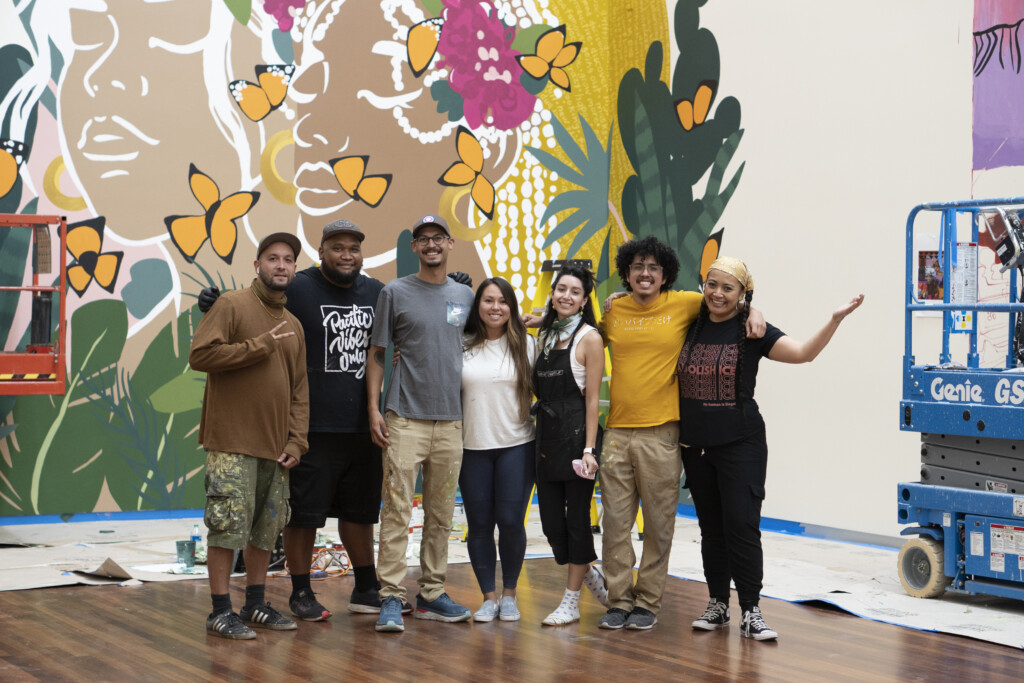
For the UMFA piece on the hall’s large east facing side, easily triple the size of the UMOCA mural, the trio created Fuerza del Amor, which includes beautifully rendered graphic text on opposite sides of the mural. On the left, in English, is the phrase, “Find strength in love to heal,” while on the right, in Spanish, the text reads, “Encuentra fuerza en el amor.”
RAK’s work has an unmistakable signature attached to it, in its many iterations, which reflect core interests of each artist. Novoa is focused on lettering, graphics and calligraphic traditions of numerous cultures, but primarily arising from the Los Angeles native’s Mexican heritage. Ochoa, who was born in Colima, Mexico, earned his bachelor’s degree in ecology and is drawn to elements of environmental conservation and preservation. Galaz, who was born in La Paz, Mexico, is drawn to ancient cultural traditions including the Mayans and Aztecs as well as artisan textile patterns. The artists are so closely knit that their work evokes a wholly organic synthesis of elements.
The RAK artists have developed a symbiotic relationship over the last five years. As Ochoa says, “We really have a strong sense of trust with each other.” Indeed, their murals convey a potent sense of lyricism, fueled in part by their interests in older generation Mexican songs and music as well as the country’s canon of poetry.
The invitation to bring the artistic voices of the street and public art forms of expression into museum spaces has been one of Utah’s most important developments in the local visual arts scene. UMOCA’s ALL WALL murals exhibition coincided with that museum’s 90th anniversary celebration. RAK also has a mural up this month at Ogden Contemporary Arts for their Vida, Muerte Y Justicia exhibit. RAK’s mural is titled, Amor Eterno – Nunca Te Olvidare, which is inspired by a song by Juan Gabriel, one of the world’s best known singers from Mexico. RAK also produced murals for two SLC homeless resource centers, a project coordinated by the Salt Lake City Arts Council.
Other murals in the UMFA exhibit include Ella Rises, featuring artists Zully Davila and Evelyn Haupt. Ella Rises is a Provo-based nonprofit whose mission is to inspire Latinas in junior high and high school with hope, confidence and purpose. The mural represents ideas from the nonprofit participants, who also contributed to painting the mural.
Whānau, a Maori language word that translates roughly to the ideal of an extended family not just in the current generation but expanding to those of ancestral roots, is the epitome of caring and protecting a family’s loved ones during an event such as the pandemic. The work comes from Bill Louis, a Polynesian (Tongan/Fijian) urban abstract artist, who emphasizes the visible impact of the local Polynesian community. Utah ranks among the top destinations in numbers of Tongans and Samoans living in the U.S., most notably in Salt Lake City and West Valley City. Louis also produced a mural for the UMOCA exhibition. Louis creates a spectacular presence in his work with individuals emanating from and intertwined with relevant abstract elements that accentuate many layers of emotions and meaning of the Maori word.
Vaimoana Niumeitolu, an artist and educator born in Tonga and raised in Hawai’i and Utah, produced Blackness Brings Forth Life, a work that immerses the viewer in the totality of indigenous roots and the immense diaspora of the community in its formidable presence of coping and life during the pandemic.
The murals exhibition also incorporates community responses through a Voices of 2020 hotline. Utahns are invited to call the hotline at 801-581-8336 and record a reflection, up to three minutes maximum, to be shared with the muralists and potentially more museum visitors. Listen to some Voices of 2020 here.
See the UMFA website for current hours of operation, admission, directions and ticket information.
KEYA TAMA: HOME AGAIN (AVIA APARTMENTS)
Home Again is the tallest and largest scale mural project Keya Tama, a South African native who splits his time between Los Angeles and New York City, has undertaken. The mural, on the west side of the new Avia Apartments, facing toward Library Square in downtown Salt Lake City, rises nine and a half stories to a height of 112 feet and measures 20 feet across. In an interview with The Utah Review, Tama says he was excited at the prospects when New Orleans-based The Domain Companies reached out to him, while learning how the developer was well known for adding murals and purchasing original artwork for the interior spaces of their projects. “They gave me the freedom to design the concept,” Tama says, adding that, “I submitted a sketch but they did not have any notes” for revising it.
Tama quickly settled on geometric shapes for the design, which emphasizes harmonious balances in the natural surroundings of the city and nearby mountains. He aimed for a subtle emotional feel to unify the elements of the mural by using monochromatic pastel hues of green. To represent hope and opportunity springing from every direction, Tama used a pair of birds while the experience of celebrating nature was conveyed by dancing persons holding flowers, along with animal symbols and the placement of hands in each corner of the mural design. A woman holding an umbrella for a companion signifies care for each other and community and they are holding flowers as well.
The magnitude of the scale hit Tama once the project architect produced a mock-up of how the finished wall mural would appear. He says that they had to recalibrate the mural grid design to account for two inches that had not been previously acknowledged.
Tama says the process of painting on metal went quicker than what observers might expect. They finished painting in two weeks. He had a close friend assist him, with both wearing safety harnesses as they maneuvered on the lift taking them to the higher stories of the mural. Their biggest concern was a lightning strike during a thunderstorm. The biggest challenges artistically were the birds at the top of the mural and, as he explained, “the math involved in the design contrasted with the sun and head turned out to be incredibly difficult as a factor.”
Tama says he enjoyed his time in the city. “I met so many people on the art scene and I was excited to see the work of so many street artists,” he adds. “It is so encouraging to see street art emerging from a vibrant youth culture and being developed in the public eye.”
Tama, who has worked professionally as an artist and muralist since the age of 13, is inspired by minimalism that synthesizes ancient and contemporary iconography and there is a definite graphic arts feel to his work, as evidenced in this latest mural. Even when viewed from the next block immediately to the west along 400 South by the Library TRAX Light Rail Station, the mural’s images pop with recognition and captivate virtually any passer-by’s attention.
PHILLIP ADAMS: THE RETURN OF PINK FLOYD (THE SHOP COWORKING SPACE)
The other new large mural is located just to the east of the Avia complex in another two projects by The Domain Companies, The Shop coworking space for local professionals, businesses and nonprofits, and Mya Apartments, which is intended for median and lower income residents. Phillip Adams, an artist based in Philadelphia, was inspired by one of the most widely shared local stories about nature — a flamingo named Pink Floyd who escaped from Tracy Aviary more than 30 years ago and fled to the Great Salt Lake, where it was last seen in 2005. The mural is seen on the south side of the complex.
As with Tama, the Domain Companies architectural staff tapped Adams for the commission earlier in the construction process. Adams, in an interview with The Utah Review, says he was excited to work in SLC with its landscapes and “epic peaks,” as he describes them. To help illustrate the story of Pink Floyd’s return, he synthesized themes of the Americana symbolism of plastic pink flamingos as well as the natural habitats of Chilean flamingos, which paralleled nicely to the briny character of the Great Salt Lake and the high desert landscapes of Utah, notably Sundial Peak in the Wasatch Range.
“Much of my work pivots around something playful or absurd juxtaposing these landscapes, providing a focal point for contemplation,” he writes in an artist’s statement. “As I researched the history of SLC, I came across the story of Pink Floyd and instantly fell in love with it. A few years back, I did a drawing that had included pink flamingo lawn ornaments following a ridge in the Eastern Sierras. As they were meant to explore ideas regarding our need to control and alter the natural world, I was particularly excited about learning that in fact the Great Salt Lake is a perfect habitat for pink flamingos.”
Adams adds that the building’s lenticular shape was a natural fit to convey the ideal experience of Utah’s natural beauty unfolding before one’s eyes as residents hike or bike or participate in recreational sports. As with Tama, this was one of the largest public art projects for Adams, measuring 100 feet wide and rising five stories.
The painting took four weeks, with two weeks spent on the main wall and the other two weeks on the vertical ridges in the lenticular shape. Painting with brushes and acrylic paint by hand, Adams started with the main wall, featuring Pink Floyd, using the vertical lines of the building’s ridged siding and the floor separations as his grid, while he drew outlines of the mountains and Pink Floyd. “I layered the paint, building textures and developing the contrast between the foreground and background,” he explains in his artist statement. “I then moved into the lenticular part of the building, developing it in a similar way, with a rough underpainting to make sure the landscape was lined up being viewed from 500 South. I then continued building layers and refining the connections of the imagery between all the segmented walls.”
Painting on metal went easily, especially as the surfaces dried quickly on days when temperatures approached triple digits. “It was a real smooth and fast process whereas with stucco it would have been more porous,” he adds. The overall effect accomplished his objectives. Walking down 500 South, a pedestrian’s eyes easily are drawn to the mural each time they pass it.
Adams stayed nearby in an AirBNB near Liberty Park, just less than five blocks from the complex. He says it was one of the most positive public art projects he has ever undertaken. “There was an incredible level of trust with [The] Domain [Companies] as well with neighbors, residents and construction folks,” he recalls, “and the long days of work were amazing because for those four weeks up on a lift, I could always look at the epic Wasatch Range.”
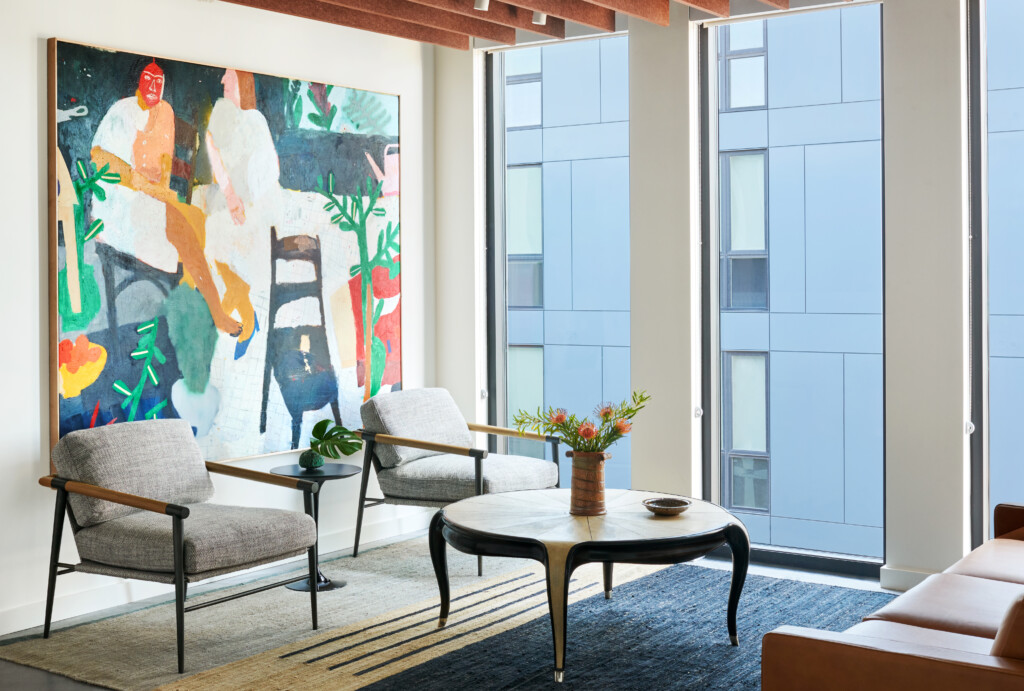
He adds that it is a “bold and beautiful” decision for communities and developers to give such weight and access to public art with the same respect as work which would be exhibited in museums and galleries. “Other murals I saw while I was here were fantastic and I had many great conversations about public art and how people enjoy living with art outside and in seeing the spaces represent different languages of art, including paint, mosaics and sculptures that represent many voices of the community.”
Adams has exhibited his work in Philadelphia at Seraphin Gallery, Arcadia University, Moore College of Art, University of Pennsylvania, Institute of Contemporary Art, Philadelphia Museum of Art, Tiger Strikes Asteroid (founding member), and Bridgette Mayer Gallery. Adams’ work has also been included in exhibitions throughout the US. His public art is featured nationally and internationally, including Montreal, most recently.
The Shop comprises 30,000 square feet of smartly designed mixed-use coworking space with the best ergonomic practices in mind including offices, open work space, conference rooms and quiet areas that would be ideal living rooms in any apartment or single-residence homes. The Shop is home to offices for several local businesses but also The Domain Companies’ MyCommunity program supports six local nonprofits by providing space, respectively, in the Mya and The Shop locations. In Mya, the organizations are Odyssey House Utah, Ronald McDonald House of Charities and Utah Food Bank. In The Shop, Equality Utah, The Green Urban Lunch Box and Wild Utah Project are supported.
The Shop is the first carbon neutral space with a rooftop in downtown Salt Lake City and is known for its business and social events, which have included Wine Academy tastings, Utah Black Chamber networking and Student Study Day, for example. The space also features works from more than 20 Utah artists.
VISIT SALT LAKE: WEST OF CONVENTIONAL MURAL TOUR
Yet another confirmation of street art’s intrinsic value to the community cultural scene is evident in the West of Conventional Mural Tour, representing a collaboration with Visit Salt Lake, Utah Arts Alliance and the office of Salt Lake County Mayor Jenny Wilson.
Featuring ten murals, the tour is free to local residents as well as visitors via a mobile link that’s delivered via text or email. There are no apps to download, and participants can win prizes while enjoying the murals in various neighborhoods. They simply check in on the Mural Tour Pass. When they’ve visited 6 of the 10 murals, they can claim their West of Conventional branded T-shirt at the Visitor Information Center at 90 South West Temple in Salt Lake, inside the Salt Palace Convention Center.
Earlier this year, Visit Salt Lake launched its newest campaign emphasizing the West of Conventional brand, which builds upon not only the city’s most widely known features and access to natural amenities but also its broad and deep spectrum of cultural strengths, a point reiterated continuously in the arts coverage of The Utah Review. In terms of accomplished muralists, the numbers in Salt Lake City, like in so many other metrics of cultural standards of excellence, indicate how the community consistently punches above its weight on a per capita basis.

UAA curated the selection of artists to focus on diverse voices and perspectives, unique styles and designs and high quality of work. The artists include Traci O’Very Covey, Shae Petersen, Josh Scheuerman, Jimmi Toro, Chris Peterson, Miriam Gutierrez, Matt Monsoon, Jorge Arellano, Bill Louis and Gerry Swanson.
Louis, for example, also produced murals for a recent exhibition at the Utah Museum of Contemporary Arts as well as the newest From Here on Out exhibition at the Utah Museum of Fine Arts. The mural featured on this tour is titled, Where We Belong, located at the Valley Fair Mall in West Valley City. It features a young Pacific Islander female who is a third-generation American.
Chris Peterson’s Queen Ursa, located at Hip & Humble near the city’s 9th and 9th neighborhood, is a statement of women solidarity. Peterson explains in a submitted artist’s statement, that the mural “embodies the feminist ideals of power, fierceness and resilience while holding her feminine beauty and maternal strength close. [Queen Ursa] guards her den of cubs, adorned with a collage of embroidered, painted, and woven flowers sourced from around the world
Jorge Arellano ‘s mural, This Is How We Move, located at the SLC Science Center for Education (1350 Goodwin Avenue), was created with design suggestions from students in the Rose Park neighborhood. His artist statement includes the following: “The students decided to focus on making this mural with Polynesian and Mexican themes, which is reflected in the patterns and colors we chose for this design.”
A Little Bit Wild, A Little Bit Rooted, located at The Copper Mine Saloon – (9071 West Main Street) in Magna, was created by Miriam Gutierrez with art by Mermacita. As noted in her artist statement, Gutierrez highlights just how quickly one can travel from an urban setting to a spectacular natural one: “Just west of the city you will arrive in Magna, Utah where you can experience the comfort of living in a small town. Most of the locals grew up here and have a long history with the Kennecott Copper Mine. It is close enough to head down to the city or maybe even visit the Great Salt Lake and Antelope Island for a day trip.”
Matt Monsoon’s mural graces the Brighton Resort and is tentatively titled, Raven Steals the Sun, which reminds of the legend that is part of the narrative tradition of the Haida people in western Canada. The legend chronicles a clever raven who brought back a ball of light from another planet to ours, thereby ending the Earth’s total darkness. “The raven was originally white, but in holding the burning ball of light, his feathers were blackened in dark soot,” Monsoon notes in his artistic statement. “As the ball began to crumble in his beak, raven had to let go. The biggest chunk drifted off to become the sun, the second biggest became the moon, and the fragments that remained floated into the heavens to become the stars.”
For more information about the ten murals and the artists, see the Mural Tour Pass page at the Visit Salt Lake website.

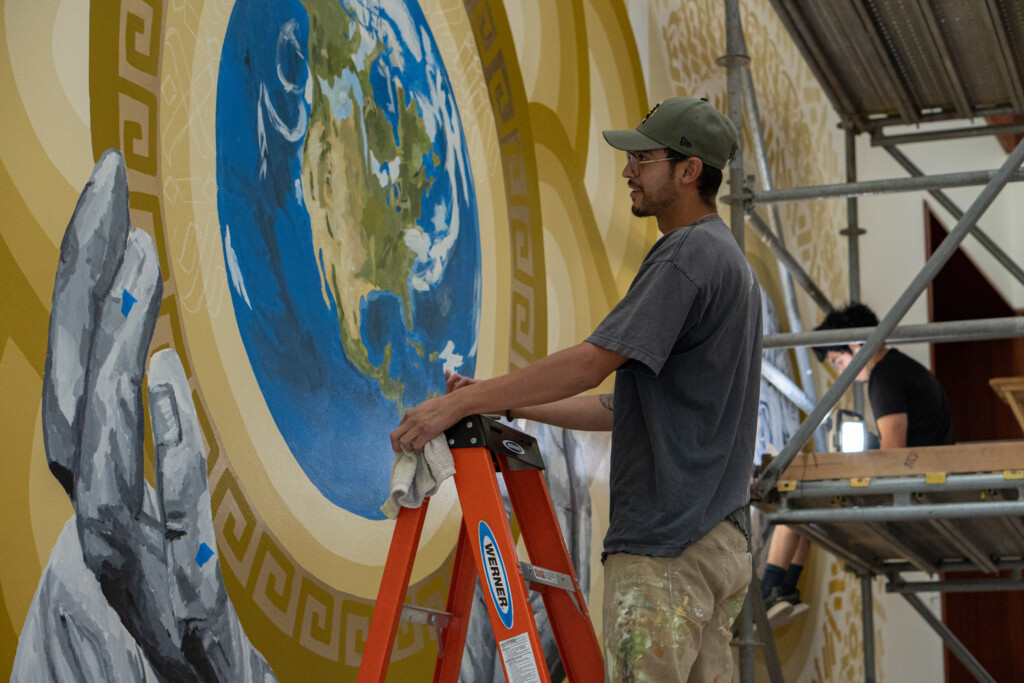
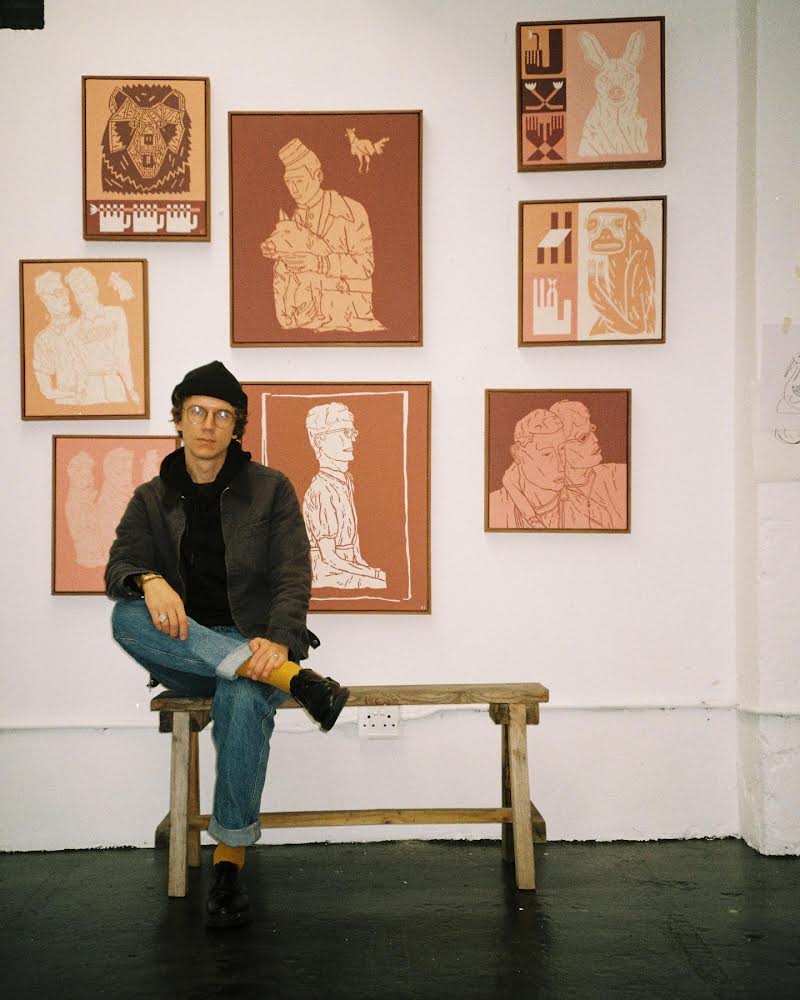


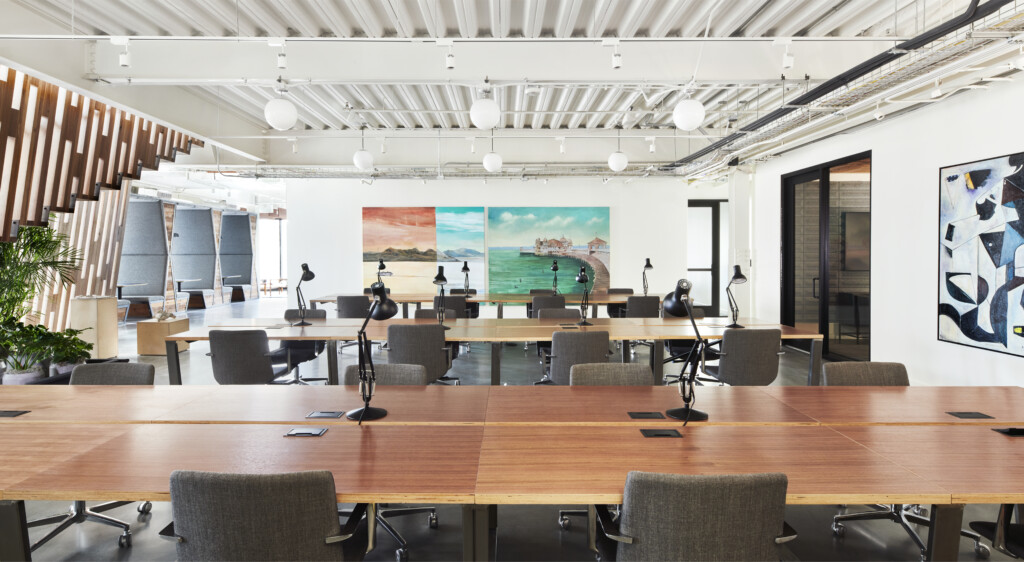

2 thoughts on “Salt Lake City’s golden age of street art in murals acknowledged by Utah Museum of Fine Arts, new downtown complexes, Visit Salt Lake tour opportunity”